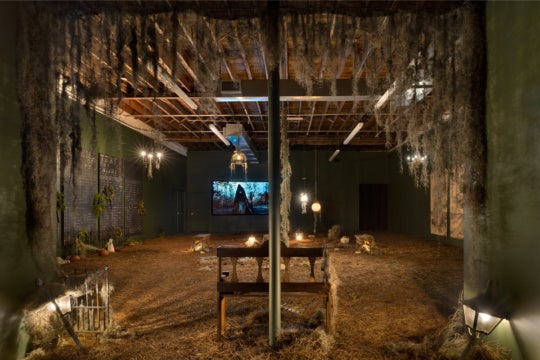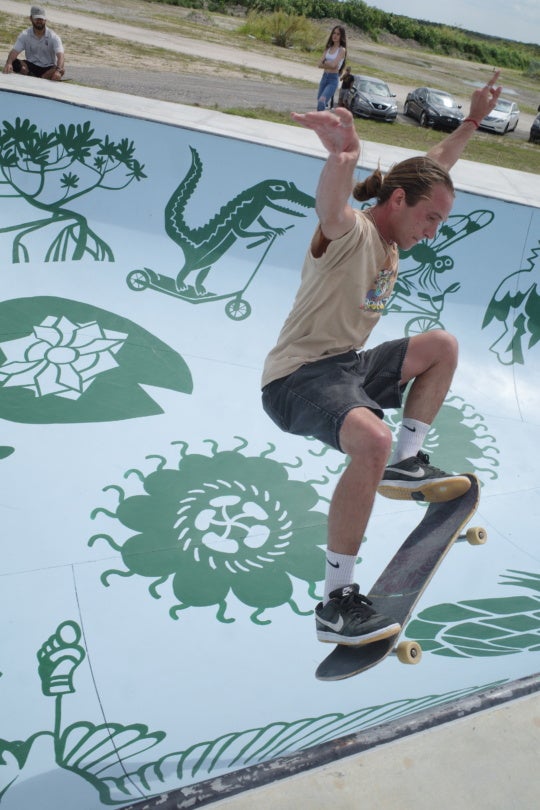
I recently spent the afternoon at the Goat Farm Arts Center with the team from Saïah, an Atlanta-based performing arts company, as they prepared for their new performance, Rua | Wülf. The heightened energy was apparent as the team put finishing touches on a production that has been over a year in the making. Opening night begins at 7:30PM this Wednesday, April 11, 2011, and the show continues with performance dates through April 29 (click here for more ticket info).
Rua | Wülf is a reworking of the story of Little Red Riding Hood. Saïah does away with the fairy tale’s story of binary good and evil and delivers something more nuanced, real, and therefore more frightening. This telling of the familiar story explores the theme of choice and consequence and the lingering implications of both.
Click above to play the second official trailer for Rua | Wülf, or click here to view it at YouTube.
Utilizing almost every nonresidential space of the 12-acre property at the Goat Farm, the production is expansive, to say the least. At sundown on the night of each performance, the audience will follow the actors as they move in and out of the Goat Farm’s dramatic industrial architecture. Saïah’s creative team has collaborated with local artists and craftspeople to create dynamic set pieces and fabricate densely textured costumes which respond to the Victorian history of the Goat Farm.
I was able to stay for a partial rehearsal of the show. It was a bright afternoon, but, even without the mysterious veil of night, and despite the fact that the performers were in t-shirts rather than costumes, the power of what Saïah has done is unmistakable. After my visit, I followed up with Marium Khalid, cofounder of Saïah and director of Rua | Wülf, about the process of bringing to life this ambitious re-imagining of the classic fairy tale.



Henry Detweiler (HD): First thing’s first: Why Little Red Riding Hood?
Marium Khalid (MK): When you were little, how many times did your parents tell you “Don’t talk to strangers,” or some variation of that?
Out of all the fairy tales, this is one that stood out to us particularly, because even to this day, people tell it not just as a story, but as a lesson to be learned. … And yet, what is fascinating is how two-dimensional the characters have become over time.
In some of the oldest versions we discovered, Red is asked to strip [and] eat the flesh and drink the blood of her own grandmum by the wolf. It is vulgar. It is grotesque. However, she acknowledges her own gut, the “uh oh” feeling, and runs out of the house, saving herself. From that level of self-faith, somehow we’ve programmed ourselves to wait for “the Huntsman.”
HD: How long has the performance been in development? And could you talk a little bit about that process?
MK: I began research for this story earlier last year while we were in the middle of our show City of Lions and Gods. I suppose the nature of that play inspired [our audience], because after almost every performance, I had audience members come and tell me their own stories about when they were victims or predators. It was surreal to witness people be so open.
So, stomping around the goat farm with these stories buzzing in my head, it seemed like the perfect path to walk down. So I proposed the idea to heads of Saïah, and we were off from there.
As far as writing goes, I began actually writing in August of 2011. We had a writing team together who would bounce ideas back and forth, twists, realizations, etc. Once the story was on its way, we held auditions, and it all began the journey.



HD: The set pieces and costumes create a rich sense of atmosphere which is heightened by the backdrop provided by the Goat Farm. How has working in this dramatic space informed the look of the performance?
MK: How could it not?! Have you seen this space? It’s something out of a poet’s imagination.
The presence of the Goat Farm Arts Center had a huge hand in shaping this story. The path naturally created itself. The thing we always made sure of is that we never wanted to fight the space. We wanted it to give us what it wanted, and we offer our world to it. So the sets and costumes are an extension, not a manipulation of this world. Luckily for us, it is a beautiful world we live in.
HD: During the performance, the audience will be led through a series of set pieces located in almost every corner of the Goat Farm. What challenges and opportunities has this provided in creating the show?
MK: Well it’s 12 acres, so it’s a lot of walking. Ha!
I guess [there were] not a great many challenges, [but] more like, “How do we make this work?” It is an old factory. It is an artist work space. So [there are] loads of old wood, machine shops, puddles, and creatives. But like I said, we’re trying to embrace it all. If you see a puddle, we encourage you to play in it! Just be sure to wear comfortable shoes.

HD: Saïah is collaborating with many local artists to bring Rua | Wülf to life. What have some of these contributions been?
MK: We have the most brilliant lot of artists on board. Everyone from sculptors, to blacksmiths, to imagineers! But in all honesty, we are one lucky and grateful company. We sent out a mass call to artists at the beginning of this process to design 19 sets and got an amazing response back. 90 percent of what you see is handmade, from scratch and with re-found objects. But I can’t say much more without giving too much away. Come and see it for your selves.
HD: I know that the production is being partially funded by a very successful Kickstarter campaign. Could you describe what the experience of using Kickstarter has been like for Saïah? And how valuable do you think this platform of direct community-to-artist funding will be to furthering the future efforts of your group and the arts community at large?
MK: Kickstarter was amazing, but let me tell you, [the campaign was] one of the most nerve-wracking few months of my year! You do your best to offer what you can and hope that people will appreciate it. But then everyday you’re at an alter prayer: “One more person, c’mon universe, one more!” But the support we got was unreal, mate. It was honestly what pushed us further in our will to do right by this show.
This experience has changed the way we create. Now it’s not this faraway grant or funding that only come to [groups who are] already supported or established. It’s immediate. It’s direct. It’s community. It takes a village to support each other’s dreams. And they are coming true.




